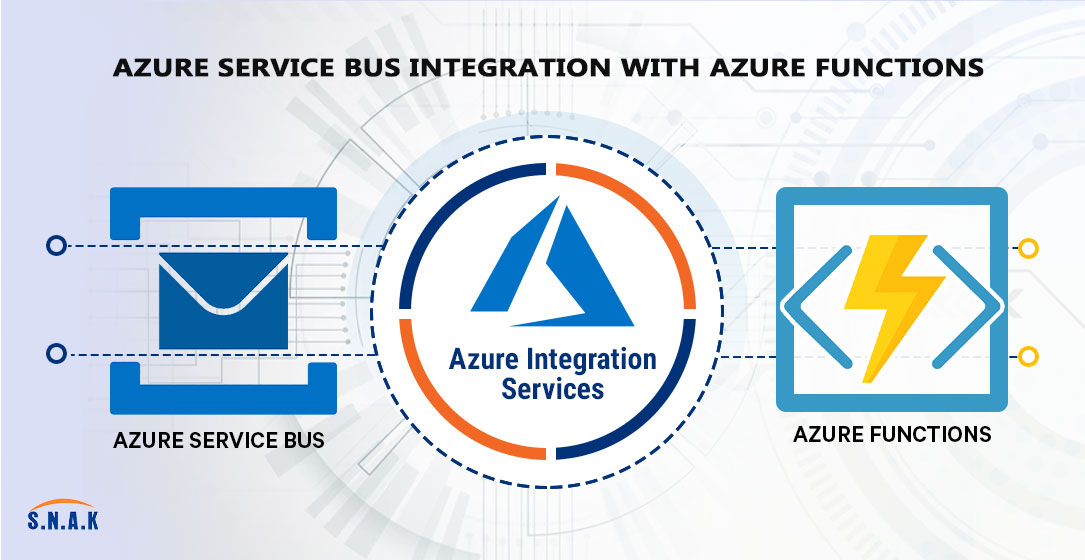January 18, 2024 | SNAK Consultancy
Share on :
A Deep Dive into Azure Service Bus Integration with Azure Functions

In the ever-evolving landscape of cloud computing, Microsoft Azure has emerged as a powerhouse, providing a comprehensive suite of services to meet the diverse needs of businesses. Among these, Azure Service Bus and Azure Functions stand out as key components that enable efficient messaging and serverless computing. This blog aims to explore the integration between Azure Service Bus and Azure Functions, showcasing the synergy between these two services.
Understanding Azure Service Bus:
Azure Service Bus is a fully managed enterprise integration message broker service. It allows the decoupling of applications and services by enabling them to communicate asynchronously. This facilitates building scalable and flexible applications that can adapt to varying workloads.
Key features of Azure Service Bus include:
1. Messaging Patterns:
(a) Supports both one-way and two-way messaging patterns.
(b) Queues and topics for point-to-point and publish-subscribe scenarios, respectively.
2. Reliability:
(a) Ensures message delivery through features like at least once delivery and dead-lettering.
(b) Built-in support for duplicate detection.
3. Scalability:
a)Scales elastically with the ability to handle varying workloads.
4. Security:
(a) Integrates seamlessly with Azure Active Directory for authentication and authorization.
(b) Supports Shared Access Signatures for secure access.
Understanding Azure Functions:
Azure Functions, on the other hand, is a serverless compute service that enables developers to build, deploy, and scale applications without the need to manage infrastructure. It allows you to focus solely on your code, while Azure takes care of the underlying infrastructure.
Key features of Azure Functions include:
1. Event-Driven:
(a) Triggers based on events, such as HTTP requests, timers, or changes in data.
2. Scalability:
(a) Scales are automatically based on demand.
3. Language Support:
(a) Supports multiple programming languages, including C#, JavaScript, Python, and more.
4. Integration:
(a) Seamless integration with other Azure services and third-party APIs.
Integration of Azure Service Bus with Azure Functions:
The integration between Azure Service Bus and Azure Functions opens up a plethora of possibilities for building robust and scalable applications. Here's how you can achieve this integration:
1. Azure Service Bus Trigger:
(a) Azure Functions can be triggered by messages in Azure Service Bus queues or topics.
(b) This trigger ensures that your function is executed in response to incoming messages, allowing for event-driven processing.
2. Input and Output Bindings:
(a) Leverage input and output bindings to simplify the integration code.
(b) Easily read messages from Azure Service Bus and write responses back without the need for complex handling.
3. Message Processing:
Azure Functions enable you to process messages efficiently, performing tasks such as data transformation, validation, or triggering subsequent actions.
4. Error Handling:
(a) Implement robust error handling to manage scenarios where messages fail to be processed.
(b) Utilize dead-letter queues for storing messages that couldn't be processed successfully.
Benefits of Azure Service Bus Integration with Azure Functions:
1. Scalability and Cost-Efficiency:
(a) Azure Functions scale automatically, ensuring efficient resource utilization and cost savings.
(b) Azure Service Bus scales dynamically to accommodate varying workloads.
2. Flexibility in Architectural Patterns:
(a) Supports various messaging patterns, including point-to-point and publish-subscribe, offering flexibility in designing application architecture.
3. Reduced Development Time:
Leverage bindings and triggers to simplify code, reducing development time and allowing developers to focus on business logic.
4. Fault Tolerance:
Built-in features of Azure Service Bus, such as duplicate detection and dead-lettering, contribute to the overall fault tolerance of the system.
5. Event-Driven Processing:
Achieve true event-driven processing by triggering Azure Functions based on messages in Azure Service Bus, enabling real-time responsiveness.
Use Cases:
1. Order Processing:
(a) Azure Functions can be triggered by incoming orders in a Service Bus queue, processing them in real time.
(b) Integration with other Azure services like Azure SQL Database can facilitate seamless order processing.
2. Real-time Analytics:
(a) Analyze streaming data by triggering Azure Functions in response to messages in a Service Bus topic.
(b) Process and transform data for real-time analytics or reporting.
3. Inventory Management:
Implement an inventory management system by processing inventory update messages from a Service Bus queue.
Update inventory levels and trigger alerts for low stock.
Questionnaire
Q: What is Azure Service Bus and Azure Functions integration?
A: It's a powerful combination allowing seamless communication and event-driven processing. Azure Service Bus handles messaging, and Azure Functions execute code triggered by these messages, ensuring scalability and flexibility.
Q: What benefits does this integration offer?
A: It provides automatic scalability, cost efficiency, flexibility in architectural patterns, reduced development time, and fault tolerance. The synergy of Azure Service Bus and Azure Functions enables real-time event-driven processing for various use cases.
Q: How does Azure Functions integrate with Azure Service Bus?
A: Azure Functions can be triggered by messages in Azure Service Bus queues or topics. Input and output bindings simplify integration, allowing for efficient message processing and response handling.
Q: What are the key features of Azure Service Bus and Azure Functions?
A: Azure Service Bus offers reliable messaging, scalability, and security. Azure Functions provide serverless computing, event-driven triggers, and support for multiple programming languages, ensuring flexibility and ease of use.
Conclusion :
In conclusion, the integration of Azure Service Bus with Azure Functions opens up a world of possibilities for developers and architects aiming to build scalable, flexible, and efficient solutions. By leveraging the strengths of both services, organizations can create robust applications that respond to events in real-time, scale dynamically and operate with high reliability.
As technology continues to advance, the seamless integration of Azure services provides a solid foundation for building modern, cloud-native applications that can adapt to the ever-changing demands of the digital landscape.